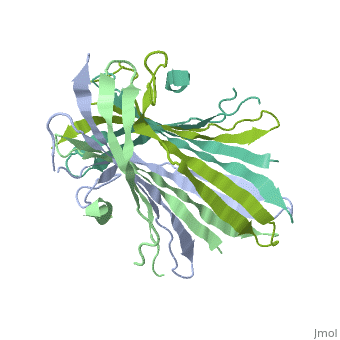User:Vinícius M. Neto/Sandbox 1
From Proteopedia
(Difference between revisions)
| Line 3: | Line 3: | ||
This is a default text for your page '''Vinícius M. Neto/Sandbox 1'''. Click above on '''edit this page''' to modify. Be careful with the < and > signs. | This is a default text for your page '''Vinícius M. Neto/Sandbox 1'''. Click above on '''edit this page''' to modify. Be careful with the < and > signs. | ||
You may include any references to papers as in: the use of JSmol in Proteopedia <ref>DOI 10.1002/ijch.201300024</ref> or to the article describing Jmol <ref>PMID:21638687</ref> to the rescue. | You may include any references to papers as in: the use of JSmol in Proteopedia <ref>DOI 10.1002/ijch.201300024</ref> or to the article describing Jmol <ref>PMID:21638687</ref> to the rescue. | ||
| + | |||
| + | |||
| + | == Relevance == | ||
| + | |||
| + | Silk fibers from Bombyx mori have been utilized by mankind since ancient times due to its remarkable mechanical properties and comfort when woven into fabrics, its earliest record being around 2.700 BC. It is thermally comfortable, elastic, strong and soft and that is why it is highly sought after as a luxury fabric for garments. It is also biocompatible, making it even applicable as a medical biomaterial for sutures or scaffolds. | ||
| + | |||
| + | Bombyx mori silkworms naturally use their silk to construct a cocoon at the end of the final stage of larval development before cocoon formation, before they undergo metamorphosis into a moth. During the natural spinning process, the silkworm extrudes the silk dope (a water-soluble liquid crystalline state containing up to 30%wt/vol fibroin in water) from its spinnerets into the external environment. This process involves mechanical shearing, stretching, and water evaporation. The delicate gland conditions (silk dope acidification, concentration changes of metal ions, and water content reduction) are crucial for the proper folding of fibroin into micelles and then liquid crystals. | ||
== Function == | == Function == | ||
| Line 21: | Line 28: | ||
Interactions between acidic residues in FibNT are critical for pH-sensitive behavior. Near the transition point (pH ~6.0), some residues exhibit up-shifted pK<sub>a</sub> values, allowing them to remain ionized at neutral pH. This sustained negative charge creates electrostatic repulsion, actively preventing premature folding and β-sheet assembly. For example, at higher pH, <scene name='10/1082417/Essential_h_bonds/2'>key hydrogen bonds</scene>—such as those between <span style="background-color:black; color:yellow;">'''Glu56–Asp44'''</span> and <span style="background-color:black; color:cyan;">'''Asp100–Glu98'''</span>—are disrupted, destabilizing β-sheet conformations until protonation occurs at lower pH. | Interactions between acidic residues in FibNT are critical for pH-sensitive behavior. Near the transition point (pH ~6.0), some residues exhibit up-shifted pK<sub>a</sub> values, allowing them to remain ionized at neutral pH. This sustained negative charge creates electrostatic repulsion, actively preventing premature folding and β-sheet assembly. For example, at higher pH, <scene name='10/1082417/Essential_h_bonds/2'>key hydrogen bonds</scene>—such as those between <span style="background-color:black; color:yellow;">'''Glu56–Asp44'''</span> and <span style="background-color:black; color:cyan;">'''Asp100–Glu98'''</span>—are disrupted, destabilizing β-sheet conformations until protonation occurs at lower pH. | ||
| - | |||
| - | == Relevance == | ||
| - | |||
| - | Silk fibers from Bombyx mori have been utilized by mankind since ancient times due to its remarkable mechanical properties and comfort when woven into fabrics, its earliest record being around 2.700 BC. It is thermally comfortable, elastic, strong and soft and that is why it is highly sought after as a luxury fabric for garments. It is also biocompatible, making it even applicable as a medical biomaterial for sutures or scaffolds. | ||
| - | |||
| - | Bombyx mori silkworms naturally use their silk to construct a cocoon at the end of the final stage of larval development before cocoon formation, before they undergo metamorphosis into a moth. During the natural spinning process, the silkworm extrudes the silk dope (a water-soluble liquid crystalline state containing up to 30%wt/vol fibroin in water) from its spinnerets into the external environment. This process involves mechanical shearing, stretching, and water evaporation. The delicate gland conditions (silk dope acidification, concentration changes of metal ions, and water content reduction) are crucial for the proper folding of fibroin into micelles and then liquid crystals. | ||
</StructureSection> | </StructureSection> | ||
Revision as of 19:54, 18 June 2025
Your Heading Here (maybe something like 'Structure')
| |||||||||||
References
- ↑ Hanson, R. M., Prilusky, J., Renjian, Z., Nakane, T. and Sussman, J. L. (2013), JSmol and the Next-Generation Web-Based Representation of 3D Molecular Structure as Applied to Proteopedia. Isr. J. Chem., 53:207-216. doi:http://dx.doi.org/10.1002/ijch.201300024
- ↑ Herraez A. Biomolecules in the computer: Jmol to the rescue. Biochem Mol Biol Educ. 2006 Jul;34(4):255-61. doi: 10.1002/bmb.2006.494034042644. PMID:21638687 doi:10.1002/bmb.2006.494034042644

